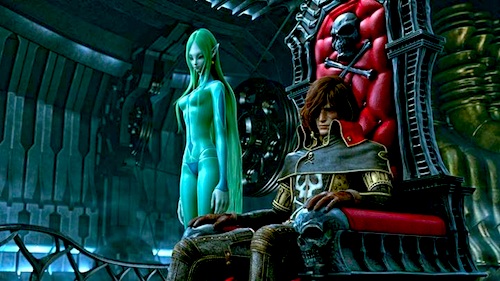By Joe Bendel. Captain Harlock was the original libertarian space pirate, inspiring a small but hearty band of followers, such as L. Neil Smith’s Henry Martyn. Harlock and his crew still sail for freedom’s sake exclusively, but he now has an apocalyptic environmental axe to grind. Leiji Matsumoto’s brooding hero of the anime of your youth gets a motion-capture computer-generated reboot in Shinji Aramaki’s Harlock: Space Pirate, which releases today on DVD.
In the far future or long, long ago, humanity is toast. We spread like roaches across the galaxy, until malaise and resource depletion set in. Recognizing the end is nigh, most colonists decided they wanted to return to their spiritual home: the Earth. Of course, the little blue planet could not sustain the billions of prospective home-comers, so the ruling authorities revoked the welcome mat. After the resulting Homecoming War, the Gaia Coalition emerged, declaring the Earth off limits. However, this did not sit well with Captain Harlock and his crew, who take every opportunity to harass Coalition ships.
Clearly, Harlock has been quite successful at this piracy thing, considering how long he has been at it—reportedly a century, give or take. It is his ship’s Dark Matter engine that keeps him so young and elusive. The Arcadia is the product of alien technology developed by the willowy, but sadly nearly extinct Juran beings. The mysterious Mimay might just be the last of her kind. She might also be Harlock’s mistress, but that remains ambiguous.
Ezra, the Coalition’s wheelchair bound fleet commander is so determined to capture Harlock, he sends his younger brother Logan on a mission to infiltrate the Arcadia. If Harlock should happen to kill Logan instead, Ezra is pretty much okay with that too. However, Harlock is onto Logan from the start, but he sees potential in the lad.
Frankly, this film represents some of the best mo-cap animation yet produced. The figures are life-like, but not slavishly so. Indeed, they often defy physics in the grandly cinematic action sequences. As it often the case with sf and fantasy anime, there is a little too much cosmic swirling in the third act, but Aramaki’s otherworldly vistas look very cool. Unfortunately, devotees of the original series will be disappointed the libertarian-resistance-to-oppression themes are largely back-burnered in favor of some over-population gobbledygook. (Can you relate, Jericho fans?)

Still, the Arcadia crew are still an appealingly colorful and dangerous lot, including the head-turning but deadly serious Kei Yuki, as well as the slovenly but resilient First Mate Yatteran. There is some suitably complex intrigue and Harlock diehards might be interested to see what aspects of the series mythology screenwriters Harutoshi Fukui and Kiyoto Takeuchi keep and what they discard. Considering the original far-flung manga and anime reached back to the American old west and 1930s Europe, you can hardly blame them for narrowing the scope somewhat.
Even if you have never seen Captain Harlock in any of his incarnations, he is immediately recognizable as an anime archetype. He is a powerful symbol, having served as an introduction to space opera for many Japanese and American kids. It is good to see him sail again, under any circumstances, but next time around Aramaki (or his successor) should really let the Arcadia crew enjoy their piracy more. As a result, it is exactly the sort of film we go into hoping to rave about, but leave with mixed feelings. Visually impressive on the outside, but a tad cold on the inside, Harlock: Space Pirate will likely divide the pre-existing fan-base when it releases today on DVD.
LFM GRADE: C+
Posted on March 31st, 2015 at 4:07pm.